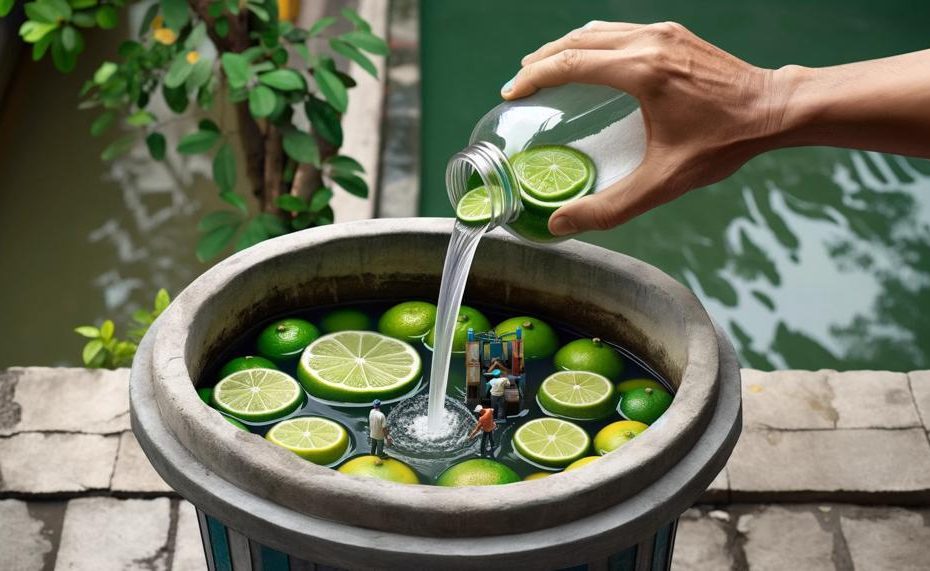Are you tired of dealing with the pungent smell and messy cleanup of lime water? Look no further, because we have all the tips and tricks for safely disposing of this common household solution. Get ready to say goodbye to the unpleasant odor and potential harm caused by incorrect disposal methods. With our comprehensive guide, you can confidently get rid of your excess lime water while also doing your part for the planet.
In this blog post, we will cover everything you need to know about properly disposing of lime water, including its impact on the environment, step-by-step instructions for correct disposal, eco-friendly alternatives, common mistakes to avoid, and tips for storing and transporting before disposal. So, how do you dispose of lime water safely?
Hydrated lime, also known as calcium hydroxide, can be hazardous to human life and the environment. It can cause skin burns, eye damage, or respiratory irritation. Prolonged and unprotected exposure can be fatal.
Here are some ways to dispose of hydrated lime:
- Recycle
- Neutralize
- Keep out of reach of children
- Dispose of only at licensed waste facilities
- Dispose in accordance with local and national legislation
- Collect in containers for disposal as trade waste
- Dispose of packaging in appropriate general waste collection
To neutralize limewater, you can:
- Slowly add dilute hydrochloric acid to the base until the mixture is neutralized to about a pH of 7
- Pour the final solution down the drain with at least a 20-fold excess of water
You should not dispose of limewater to a landfill as they pose a corrosive hazard.
Contents
Important Tips When Disposing of Lime Water
When disposing of lime water, it is crucial to follow proper safety precautions to prevent harm to yourself and the environment. Here are some important tips to keep in mind:
- Handle with care: Lime water can cause skin irritation, eye irritation, and nausea if not handled properly. It is important to wear protective gear such as gloves, goggles, and a face mask when handling this substance.
- Store correctly: In households, lime water should be kept in a designated cupboard and labeled as corrosive. Make sure to use a container with a tight-fitting lid to avoid any accidental spills.
- Dispose as hazardous waste: Calcium hydroxide solutions should be disposed of as hazardous waste and labeled as corrosive. This ensures that professionals handle and dispose of it correctly.
- Pour over ice: The safest way to dispose of quicklime is by pouring it over ice. This method helps cool the substance and manage any exothermic reactions. Avoid adding water directly to quicklime as it can release heat and gas.
- Use absorbent materials: In case of any spills, use non-combustible absorbent materials like cat litter or dirt to soak it up before disposal. If these materials are not available, use a towel or rag and then wash them in a machine.
- Drain disposal: To dispose of lime water down the drain, run high-pressure water for 1-2 minutes while pouring the solution. This will dilute the solution and ensure safe disposal.
- Be aware of its uses: Quicklime has been historically used for purposes like preserving corpses and improving soil quality. It is also commonly used in the water treatment industry. Knowing its potential uses can help ensure proper disposal.
How to Dispose of Quicklime?
Proper disposal of quicklime (calcium oxide) is crucial to prevent potential hazards and environmental pollution. To ensure safe disposal, here are some recommended methods for disposing of quicklime:
- Store in a designated corrosive cupboard: In household settings, it is important to store quicklime in a designated cupboard labeled as “corrosive.” This not only ensures proper storage but also helps prevent accidents from occurring.
- Pour over ice: When disposing of quicklime, the safest method is to pour it over ice. This helps to quench the reagent and manage the heat produced by the reaction with water. However, caution must be exercised when adding water to quicklime as it can release heat and gas.
- Utilize non-combustible absorbent materials: Quicklime can be absorbed using non-combustible materials like cat litter or vermiculite. Once absorbed, these materials can be disposed of in regular garbage.
- Flush down the drain: Another method of disposing of quicklime is by pouring it down the drain while running high-pressure water for 1-2 minutes. This helps to dilute and neutralize the solution, making it safer for disposal.
- Use limewater to treat acidic water or soil: In laboratory settings, limewater can be used to treat acidic water or soil. After use, it should be disposed of properly according to local regulations to prevent environmental pollution.
- Clean up spills with water or soap: In case of any spills, it is important to clean them up immediately using plain water or soap and water. This helps remove any residue and prevents skin irritation.
Ways to Dispose of Limewater
It is crucial to properly dispose of lime water, also known as quicklime, to prevent environmental pollution and potential health hazards. As a calcium hydroxide solution, it is widely used in various industries such as water treatment and agriculture. Here are some safe and eco-friendly ways to dispose of lime water:
- Dilution and flushing: The simplest way to get rid of lime water is by diluting it with distilled water and flushing it down a sink with high-pressure water. This ensures that the solution is flushed down the pipes without causing any harm to the environment.
- Mixing with organic matter: Another safe disposal method is mixing lime water with compost or using it as fertilizer for plants. Not only does this help in disposing of the solution, but it also provides essential nutrients to the soil.
- Neutralization: Lime water is highly effective in neutralizing acids, making it useful for treating acidic water or soil. If you need to dispose of lime water, it is important to first neutralize it with diluted hydrochloric acid to a pH level of 6-9 before disposal.
- Proper storage: To ensure the safety of both humans and the environment, it is crucial to store lime water in a designated cupboard with a tight-fitting lid. This prevents any accidental spills or leaks.
- Use as a cooling agent: When disposing of hazardous quicklime, it is recommended to pour it over ice to quench the reagent and manage the exotherm through cooling.
- Follow safety precautions: Whether working with lime water in a laboratory or household setting, safety precautions should always be followed. This includes wearing protective gear and using non-combustible absorbent materials to soak up any spills.
Some Other Useful Ways of Disposing Quicklime
Quicklime can be easily neutralized with water, but there are many other safe and effective ways to dispose of this versatile chemical. Some alternative methods for disposing of quicklime include:
| Method | Description | Benefits |
| Agricultural Use | Using quicklime as a soil amendment or source of calcium for crops. | – Improves soil quality – Reduces soil acidity – Promotes crop growth |
| Soil Stabilization | Mixing quicklime with soil to increase pH level and reduce plasticity. | – Suitable for construction projects – Improves soil stability |
| Landfill Disposal | Disposing of quicklime in a designated landfill. | – Safe containment – Prevents environmental hazards |
| Incineration | Burning quicklime at high temperatures in designated facilities. | – Proper ventilation is important – Avoids release of harmful gases |
| Reuse/Recycling | Reusing or recycling quicklime for various purposes. | – Reduces waste – Conserves resources – Less need for new production |

It is crucial to prioritize safety when handling and disposing of quicklime. This includes wearing protective gear, using caution when mixing with water, and following disposal guidelines set by local authorities.
Some Other Useful Ways of Disposing Quicklime
There are numerous alternative methods for safely and effectively disposing of quicklime. These methods eliminate the need for traditional disposal techniques, like burying the quicklime, which can be both time-consuming and environmentally harmful. Some other useful ways of disposing of quicklime include:
- Pouring over ice: One of the safest and most convenient ways to dispose of quicklime is by pouring it over ice. This technique quickly cools the reagent, preventing any potential hazards and managing the exotherm.
- Using absorbent materials: Non-flammable absorbent materials, such as sand or vermiculite, can be used to soak up any spills of quicklime. This method is especially helpful in laboratory settings where spills are more likely to occur.
- Flushing down the drain: Limewater, a solution made from quicklime and water, can be safely disposed of by flushing it down the drain with high-pressure water for 1-2 minutes. This method is commonly used in water treatment plants.
- Neutralizing acids: Limewater can neutralize acids, making it a useful tool for treating acidic water or soil. After use, limewater can be disposed of by flushing it down the drain or using an absorbent material to soak up any spills.
- Utilizing in water treatment: Quicklime has a wide range of applications in the water treatment industry, such as softening hard water and removing turbidity. After use, quicklime can be safely disposed of according to facility guidelines.
- Reusing for other purposes: Quicklime can also be repurposed for various uses, such as improving soil quality or preparing corn for consumption through a process called nixtamalization. Not only does this reduce waste but it also provides economic benefits.
Wrapping Up
Lime water is a by-product of the lime industry that has numerous industrial uses but must be disposed of properly to prevent harm to the environment and human health. Various methods can safely and effectively dispose of lime water, with some being more environmentally friendly than others.
One of the best and most eco-friendly ways to dispose of lime water is by diluting it with distilled water. This method involves mixing equal parts of lime water and distilled water in a closed container. By eliminating bacteria and balancing the pH level, the diluted lime water can be used as a natural fertilizer for plants or poured down the drain without causing harm to the environment.
In addition to dilution, composting is another environmentally friendly method for disposing of lime water. By adding lime water to organic matter such as food scraps and yard waste, the decomposition process can be accelerated, creating nutrient-rich compost for gardening. This method not only helps with waste management but also provides a natural and beneficial product for the environment.
Another option for disposing of lime water is by converting it into quicklime. This process involves drying limes and using them in various industries such as building materials and cleaning products. While handling quicklime requires appropriate protective gear, such as goggles and gloves, it is a safe and effective way to dispose of lime water.
Quicklime can also be used for soil stabilization by neutralizing acidity levels or enhancing plant growth. This method not only aids in waste disposal but also benefits agricultural production and promotes environmental sustainability.
Furthermore, in areas where there are water shortages or contamination, quicklime can be used to disinfect water by removing impurities and bacteria. This method is a more environmentally friendly alternative to chemical treatments and can help improve access to clean drinking water.





